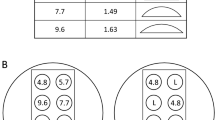Abstract
MOST of the studies on the genetic structure of wild populations of Drosophila have been on animals trapped by means of a yeasted banana-agar or similar fruit traps1,2,3. The flies may thus have been drawn from a large number of small discrete breeding units, and hence general inferences are difficult. I have found a very marked deficiency in the number of males trapped in D. subobscura Collin and to a lesser extent in D. obscura, although the sex-ratio in cultures approximates unity, thus demonstrating the inadequacy of collections by means of baited traps.
This is a preview of subscription content, access via your institution
Access options
Subscribe to this journal
Receive 51 print issues and online access
$199.00 per year
only $3.90 per issue
Buy this article
- Purchase on Springer Link
- Instant access to full article PDF
Prices may be subject to local taxes which are calculated during checkout
Similar content being viewed by others
References
Dobzhansky, Th., Proc. 7th Int. Cong. Gen. (1939).
Dubinin, N. P., and co-workers, Biol. Zh., 6 (1936).
Gordon, Spurway and Street, J. Genet., 38 (1939).
Author information
Authors and Affiliations
Rights and permissions
About this article
Cite this article
GORDON, C. Natural Breeding Sites of Drosophila obscuro. Nature 149, 499–500 (1942). https://doi.org/10.1038/149499b0
Issue Date:
DOI: https://doi.org/10.1038/149499b0
This article is cited by
-
New African species in the Drosophila obscura species group: genetic variation, differentiation and evolution
Heredity (1988)
-
An ecological classification of European Drosophila species
Oecologia (1977)
-
Untersuchungen �ber die �kologie der wildlebenden Drosophila-arten westfalens
Zeitschrift f�r Morphologie und �kologie der Tiere (1955)
Comments
By submitting a comment you agree to abide by our Terms and Community Guidelines. If you find something abusive or that does not comply with our terms or guidelines please flag it as inappropriate.



